
Burlap bags are made from a tough, natural tropical fiber called jute. It is spun into long threads that are twisted together into larger threads, which are then woven into burlap material. Some burlap used for industrial purposes is treated with chemical preservatives, but burlap used for food products such as coffee and rice is not treated. Burlap available at the garden centers is untreated.
Burlap Uses
Video of the Day
Burlap has been used in the garden for centuries as an all-purpose cloth. Sturdy, strong and not easily torn, burlap is used to store seeds and other materials, wrap tree and shrub roots for transplanting and as ground cover. Burlap withstands heavy rain, yet with time decomposes and becomes part of the soil.
Video of the Day
Poor Plant Supressant
Burlap bags make great ground cover in that they allow both water and oxygen to reach the underlying soil. However, this is not a one-way street. If the burlap is coarsely woven, then significant gaps exist in between the fibers. Plants are drawn to any sunlight they can find. If there are a large number of germinating weeds under the burlap, some will find a way to sprout through the natural gaps in the material. This is why landscapers often use burlap as a ground cover for newly sown grass seed.
Combined Effort
Burlap combined with other materials works better as a weed suppressant. For example, a 3- to 4-inch layer of straw is sufficiently thick enough to prevent any weeds from sprouting, but the straw can blow away in high winds or float away in heavy rainfall. Using burlap over the straw keeps it in place.
Interbay Mulching
A new use for burlap in the garden is the development of Interbay mulching. It is promoted as being faster and more productive than ordinary compost, with less work. The gardener merely spreads a several-inch mixture of nitrogen-based material such as garden and kitchen debris, cut grass or blood meal and carbon-based material such as leaves, hay and straw onto the ground. After wetting it thoroughly, the gardener places a heavy burlap layer over the organic material and waters it. After a few months, the area is enriched and ready for planting.